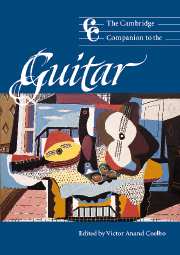Book contents
- Frontmatter
- Part I New guitar histories and world traditions
- Part II Jazz, roots, and rock
- 5 The guitar in jazz
- 6 A century of blues guitar
- 7 The turn to noise: rock guitar from the 1950s to the 1970s
- 8 Contesting virtuosity: rock guitar since 1976
- 9 The guitar in country music
- Part III Baroque and classical guitar today
- Glossary
- Notes
- Select bibliography
- General index
- Index of song and album titles
9 - The guitar in country music
from Part II - Jazz, roots, and rock
Published online by Cambridge University Press: 28 September 2011
- Frontmatter
- Part I New guitar histories and world traditions
- Part II Jazz, roots, and rock
- 5 The guitar in jazz
- 6 A century of blues guitar
- 7 The turn to noise: rock guitar from the 1950s to the 1970s
- 8 Contesting virtuosity: rock guitar since 1976
- 9 The guitar in country music
- Part III Baroque and classical guitar today
- Glossary
- Notes
- Select bibliography
- General index
- Index of song and album titles
Summary
The guitar has always played a primary role in the composition, performance, and image of country music. The steel-string acoustic guitar, or “flat-top,” provided the rhythmic and harmonic foundation in the original string bands and has since been included in all country music recordings and performances without exception. In North America, the acoustic guitar has become a symbol not only of country music, but of traditionalism, rural values, “down-homeness,” and a folk-based ideology.
The authenticity of a country music performance depends upon stylistic variables that combine to create a personal musical experience both for the audience and for the performer. Musical elements such as vocal sound, subject, performance practice, and instrumentation merge with iconographic ones such as boots, cowboy hats, pedal steel guitar, and acoustic guitar in order to maintain this authenticity and produce the genre recognized by audiences as country music.
The traditionalism associated with the acoustic guitar lives on in the repertory of folk songs, ballads, dances, and instrumental pieces brought to North America by Anglo-Celtic immigrants during the seventeenth and eighteenth centuries. British folk culture came to all regions of English-speaking North America, and pockets of tradition still exist in such places as rural New England, Appalachia, and the Maritime provinces of Canada. By the same token, country music is deeply rooted in the folklore of British broadside ballads, which were transported to the New World and gained life as “Americana.” It speaks to its audience from a rural perspective and serves as a vehicle for tapping into and assessing public opinion, relating personal experience, and commenting on situations or events.
- Type
- Chapter
- Information
- The Cambridge Companion to the Guitar , pp. 133 - 150Publisher: Cambridge University PressPrint publication year: 2003



